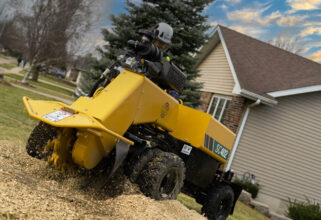Tech2Tech: EFI/DFI Series (Part I): What is the meaning and significance of EFI/DFI?
Figure 1 — Fuel filterBy Dave Worden
As service technicians, many of you have either read or attended an engine manufacturer’s service school and been hit with the latest and greatest in service repair…EFI/DFI!
EFI simply stands for “Electronic Fuel Injection” and DFI for “Digital Fuel Injection.” Why do you need to know and understand those terms, after all we are led to believe that we live in a “throw-a-way” service industry? There is also a belief that repairing today’s gasoline engines has gotten too costly, which obviously is not true as long as we understand the systems and work efficiently and effectively to repair them.
Why do doctors charge as much as they do to treat you when you are ill? After all, the human body has not changed all that much in hundreds of years. They obviously charge what they do because they have to troubleshoot and correctly diagnose what is wrong, and they have to continually update and learn the latest in medicine.
As power equipment technicians, you have to do the same thing… diagnose, identify, and correctly fix the issue with a gasoline-powered engine. After all, it really does not matter whose engine you are working on; they’re all the same in theory. You still need to be updated on the latest technology. The difference between technicians and doctors is when doctors misdiagnose, they bury their mistake and when technicians misdiagnose, the customer never lets them forget about it!
Figure 2 — Fuel railIn today’s lexicon of fancy names and all the latest in alphabet soup terminology, all you really want to know is if and how you can fix it. As you may have concluded, Electronic Fuel Injection and Digital Fuel Injection are simply another way to deliver fuel to an engine. There are many variations on EFI/DFI systems, so I will try and put it in simple and general terms. For any specific or special issues, I would urge the technician to contact that specific manufacturer.
EFI/DFI components
Figure 3 — Fuel injector
Figure 4 — Oil temperature sensor
As with any procedure, it is best to have a good working knowledge of engine basics; understanding the theory of them will make working and diagnosing them much easier.
Following is a list of principle components that can be found in most of the EFI/DFI systems being used in today’s power equipment:
Fuel pump: Pumps fuel under pressure to feed the injectors.
Fuel filter: Self explanatory but it should be able to handle proper pressure regulations (see Figure 1).
Fuel rail: Supply line to the injectors should be high-pressure certified (see Figure 2).
Fuel lines: Important to be properly rated for high pressure.
Fuel pressure regulator: Regulates the fuel pressure.
Fuel injectors: What dictates the amount of fuel entering the combustion chamber (see Figure 3)
Throttle-body/intake manifold: Regulates the fuel/air flow entering the engine.
Engine/electronic control unit (ECU): Monitors and controls the electrical signals to the engine while running.
Ignition coil: Supplies the necessary spark to the plugs under certain conditions.
Oil temperature sensor: Senses the temperature of the oil to help determine the amount of fuel/air for starting or running conditions (see Figure 4).
Figure 5 — Throttle position sensor
Figure 6 — Oxygen sensorThrottle position sensor (TPS): Senses where the throttle needs to be when starting, running, or reacting to loads (see Figure 5).
Speed sensor: Determines the speed of the engine.
Oxygen sensor: Senses oxygen in the exhaust, sometimes referred to as a Lambda Sensor (see Figure 6).
Air temperature sensor: Looks at air temperature.
Pressure sensor: Determines pressure whether it is fuel or air.
Water temperature sensor: Determines the running temperature for liquid-cooled engines and helps with the fuel air mixture.
Air inlet temperature sensor: Looks at the incoming air and mixes with the appropriate amount of fuel.
Wire harness assembly: Key item sends critical information to the ECU.
Figure 7 — Relay
Figure 8 — Digital voltmeterRelays: Electrical Box that controls voltage flow to other components (see Figure 7).
Malfunction indicator light (MIL): A warning device and diagnostic tool to help troubleshoot and engine.
Self-diagnosis light: Same as aforementioned MIL.
Map sensors: Predetermined values or settings programmed into the ECU. They tell the ECU what ignition and injector settings are required for a specific set of conditions.
Troubleshooting tools
If you’re a service technician, you have undoubtedly attended service schools and been told that you need to have special tools in order to work on an engine. You may have even been told you had to have XYZ’s “specialty tool” in order to work on a product. I am going to tell you a secret: You do not need these tools! However, having the “specialty tool” designed by the manufacturer will make your job faster and easier, and alleviate your frustrations, which is something that needs to be considered when working on today’s sophisticated engines. The other consideration for specialty tools is that some of the warranty reimbursement rate is based upon using those tools. The suggestion would be to justify the needs. If you service a lot of EFI/DFI engines, investing in the proper tools will increase your efficiency and profitability. If you do not service these engines very often, just understand that it may take you a little longer to troubleshoot and repair them. The bottom line is to understand the objective and be realistic with what you can charge your customer for any given repair. With that said, following are commonly recommended tools:
Figure 9 — Pressure gauge
Figure 10 — Noid lightHigh-quality Digital VOA Meter: A voltmeter is an instrument used for measuring the potential electrical difference between two points in an electric circuit. Digital voltmeters give a numerical display of voltage (see Figure 8).
Pressure gauge: Select one capable of reading between 20 and 70 psi; gauges are either direct- or indirect-reading (see Figure 9).
ECU adapter or harness: Will be manufacturer specific.
Noid light: A noid light is basically a little incandescent bulb in a small socket and has an end that looks like small pins (see Figure 10).
Oetiker pliers: A specially designed plier to install Oetiker clamps (see Figure 11).
Oetiker clamps: Ear-type clamps “breathe” and adapt to the expansion and contraction of a hose affected by thermodynamics or aging — no need to retighten. These clamps are highly recommended when working with high-pressure fluids and or fuel (see Figure 12).
Troubleshooting software and interface cable: This is definitely a manufacturer-specific tool and will make the job easier and help train the technician at the same time. Cost is a consideration, but it can pay for itself in a very short period of time.
Getting to this stage with nomenclature and a brief overview of components and their function will make troubleshooting engines with EFI/DFI easier.
Figure 12 — Oetiker clamp
Figure 11 — Oetiker pliersIn the remaining articles in this series, I will cover potential problems and how to troubleshoot them. A variety of EFI/DFI engines are being offered by several manufacturers, including Kohler Co.-Engine Division (EFI), Kawasaki Engines (DFI) and Robin. As always, it is in a technician’s best interest to attend any seminars on testing or developing technology to get the manufacturers’ take on what makes their system unique. They have done a lot in the area of development and finding the best way to service their engines. This could include “specialty tools” or a flow chart to better isolate and repair an engine if a problem should arise.
Dave Worden has 40 years of extensive experience in the outdoor power equipment industry at the dealer, distributor and manufacturer levels. After beginning his career as a service technician for a dealership, he made the jump to a Central Distributor. There, he continued to work in the service department before he was promoted to educational director, representing Briggs & Stratton, Kohler, MTD and Tecumseh. He then moved up to the manufacturer level, serving as a territory manager for McCulloch Corp., a training specialist for Kohler Co. Engine Division, and a general manager for a manufacturer-owned dealership. In addition to being a contributing writer for OPE, Worden is currently operating a dealer consulting company called DJW Consultants, as well as serving as vice president of the Equipment & Engine Training Council, a committee chair for National SkillsUSA and an at-large representative for SkillsUSA Massachusetts.




